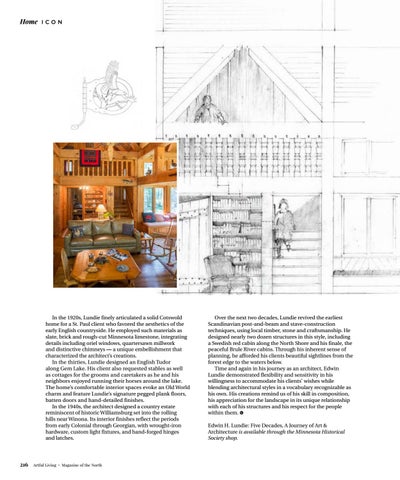Home I C O N
In the 1920s, Lundie finely articulated a solid Cotswold home for a St. Paul client who favored the aesthetics of the early English countryside. He employed such materials as slate, brick and rough-cut Minnesota limestone, integrating details including oriel windows, quartersawn millwork and distinctive chimneys — a unique embellishment that characterized the architect’s creations. In the thirties, Lundie designed an English Tudor along Gem Lake. His client also requested stables as well as cottages for the grooms and caretakers as he and his neighbors enjoyed running their horses around the lake. The home’s comfortable interior spaces evoke an Old World charm and feature Lundie’s signature pegged plank floors, batten doors and hand-detailed finishes. In the 1940s, the architect designed a country estate reminiscent of historic Williamsburg set into the rolling hills near Winona. Its interior finishes reflect the periods from early Colonial through Georgian, with wrought-iron hardware, custom light fixtures, and hand-forged hinges and latches.
216
Artful Living
•
Magazine of the North
Over the next two decades, Lundie revived the earliest Scandinavian post-and-beam and stave-construction techniques, using local timber, stone and craftsmanship. He designed nearly two dozen structures in this style, including a Swedish red cabin along the North Shore and his finale, the peaceful Brule River cabins. Through his inherent sense of planning, he afforded his clients beautiful sightlines from the forest edge to the waters below. Time and again in his journey as an architect, Edwin Lundie demonstrated flexibility and sensitivity in his willingness to accommodate his clients’ wishes while blending architectural styles in a vocabulary recognizable as his own. His creations remind us of his skill in composition, his appreciation for the landscape in its unique relationship with each of his structures and his respect for the people within them. Edwin H. Lundie: Five Decades, A Journey of Art & Architecture is available through the Minnesota Historical Society shop.
